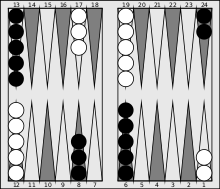Tavli
Tavli ( Greek Τάβλι , Turkish tavla) is a board game for two players that is related to backgammon and is very popular in Greece , Turkey and neighboring countries. The game is played on a backgammon board with corresponding stones and dice. The 64 backgammon dice is not used.
regulate
Tavli consists of three rounds, each of which follows slightly different rules. The small differences in the rules lead to fundamentally different game strategies, which is what makes Tavli so attractive.
The three rounds (Portes, Plakoto and Fevga) are repeated until a player has reached a predetermined number of points (usually 3, 5 or 7). All three rule variants have in common that each player tries to bring all of his stones from their starting position to a target area (home board), from where they can then be thrown out of the game. The winner is the player who first removed all of his stones from the playing field.
Round 1: Portes
The rules of the game for portes ( Greek Πόρτες ) are almost identical to those for backgammon and should only be briefly introduced here:
At the beginning of the game the stones are set up as shown in the illustration on the right. Each player rolls a dice, the one with the higher number starts the game.
Each player alternately throws two dice and moves one or two stones according to the number of points. White moves clockwise, black counterclockwise. The following restrictions apply: A stone may only be moved if the target field is free, occupied by exactly one opposing stone or occupied by any number of your own stones. A field with more than one opposing piece may not be entered. If no move is possible under this condition, the die result is forfeited and it is the opponent's turn.
If there is an opposing stone on the field, it is captured and placed in the area in the middle of the field (bar). The defeated player may only move a field stone when he has brought all the stones from the bar back into play. As in a regular move, the stone is reinserted from the starting point (field 1 or 24) using one of the thrown numbers.
If all of a player's stones are in his own home board (fields 1–6 for black and 19–24 for white), the corresponding player can begin to remove his stones from the game. This requires an exactly matching number. If the result of the die is greater than the required number, a stone may still be removed if no other move is possible.
The winner is the player who first removed all of his own stones from the game. The winner receives one point. If at this point the opponent still has all the stones on the board, the winner receives two points.
The differences between portes and backgammon are marginal:
- After the initial roll, which determines the starting player, he rolls the dice again instead of making his first move with the number already thrown.
- The winner receives one point for a simple win and two points if the opponent still has all the stones on the board, there is no backgammon (three points).
- The doubling cube (64 cube) is not used.
Round 2: Plakoto
The second round (Plakoto, Greek Πλακωτό ) differs from Portes as follows: At the beginning, the pieces are on the first field of the respective player (field 1 for white, field 24 for black)
During the game, opposing stones are not captured, but blocked:
You can move to a space on which the opponent only has one stone. The opponent cannot move this stone again until it has been released again. Your own stone that blocks an opponent's stone may not be blocked by another opposing stone at the same time. Conversely, any number of your own stones can be placed on a space on which you are blocking an opposing stone. Fields with two or more opposing stones may not be entered and therefore cannot be blocked.
In addition to the usual victory condition, a game is considered won if a player blocks an opposing stone on its starting field (mother stone). However, if the blocking player himself still has stones on his own starting field, the game continues until either his mother stone is blocked (tie) or he has removed all his stones from the starting field.
As with the Portes, you can start removing the stones as soon as all your stones have arrived on the home board.
Round 3: Fevga
The third round (Fevga, Greek Φεύγα "to run away") changes the rules of Portes as follows:
At the beginning the pieces of the players are diagonally to each other (all black pieces on field 24, all white pieces on field 12). In contrast to Portes and Plakoto, the players don't move in opposite directions, but both move counter-clockwise.
Fevga neither beats nor blocks. A stone may only be moved onto a completely free space (or onto a space that already has one or more of your own stones). This means that a chain of six can be formed faster than in the other games (i.e. 6 pieces of your own color occupy consecutive fields). Chains of six cannot be overcome by the opponent, since a die may move a maximum of 6 spaces and a space occupied by the opponent may not be entered. The first token must pass the opponent's starting point before the next token can be moved.
No player may block all six fields in his own starting area.
If a player manages to place all of his stones on the field immediately in front of the opponent's chain of six, the opponent must clear a field of the chain of six on the next move and let him pass.
